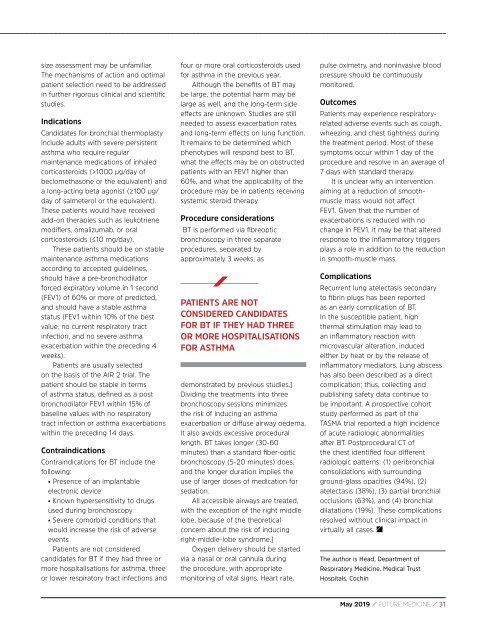may edition file
Create successful ePaper yourself
Turn your PDF publications into a flip-book with our unique Google optimized e-Paper software.
size assessment <strong>may</strong> be unfamiliar.<br />
The mechanisms of action and optimal<br />
patient selection need to be addressed<br />
in further rigorous clinical and scientific<br />
studies.<br />
Indications<br />
Candidates for bronchial thermoplasty<br />
include adults with severe persistent<br />
asthma who require regular<br />
maintenance medications of inhaled<br />
corticosteroids (>1000 µg/day of<br />
beclomethasone or the equivalent) and<br />
a long-acting beta agonist (≥100 µg/<br />
day of salmeterol or the equivalent).<br />
These patients would have received<br />
add-on therapies such as leukotriene<br />
modifiers, omalizumab, or oral<br />
corticosteroids (≤10 mg/day).<br />
These patients should be on stable<br />
maintenance asthma medications<br />
according to accepted guidelines,<br />
should have a pre-bronchodilator<br />
forced expiratory volume in 1 second<br />
(FEV1) of 60% or more of predicted,<br />
and should have a stable asthma<br />
status (FEV1 within 10% of the best<br />
value, no current respiratory tract<br />
infection, and no severe asthma<br />
exacerbation within the preceding 4<br />
weeks).<br />
Patients are usually selected<br />
on the basis of the AIR 2 trial. The<br />
patient should be stable in terms<br />
of asthma status, defined as a post<br />
bronchodilator FEV1 within 15% of<br />
baseline values with no respiratory<br />
tract infection or asthma exacerbations<br />
within the preceding 14 days.<br />
Contraindications<br />
Contraindications for BT include the<br />
following:<br />
• Presence of an implantable<br />
electronic device<br />
• Known hypersensitivity to drugs<br />
used during bronchoscopy<br />
• Severe comorbid conditions that<br />
would increase the risk of adverse<br />
events<br />
Patients are not considered<br />
candidates for BT if they had three or<br />
more hospitalisations for asthma, three<br />
or lower respiratory tract infections and<br />
four or more oral corticosteroids used<br />
for asthma in the previous year.<br />
Although the benefits of BT <strong>may</strong><br />
be large, the potential harm <strong>may</strong> be<br />
large as well, and the long-term side<br />
effects are unknown. Studies are still<br />
needed to assess exacerbation rates<br />
and long-term effects on lung function.<br />
It remains to be determined which<br />
phenotypes will respond best to BT,<br />
what the effects <strong>may</strong> be on obstructed<br />
patients with an FEV1 higher than<br />
60%, and what the applicability of the<br />
procedure <strong>may</strong> be in patients receiving<br />
systemic steroid therapy<br />
Procedure considerations<br />
BT is performed via fibreoptic<br />
bronchoscopy in three separate<br />
procedures, separated by<br />
approximately 3 weeks, as<br />
PATIENTS ARE NOT<br />
CONSIDERED CANDIDATES<br />
FOR BT IF THEY HAD THREE<br />
OR MORE HOSPITALISATIONS<br />
FOR ASTHMA<br />
demonstrated by previous studies.]<br />
Dividing the treatments into three<br />
bronchoscopy sessions minimizes<br />
the risk of inducing an asthma<br />
exacerbation or diffuse airway oedema.<br />
It also avoids excessive procedural<br />
length. BT takes longer (30-60<br />
minutes) than a standard fiber-optic<br />
bronchoscopy (5-20 minutes) does,<br />
and the longer duration implies the<br />
use of larger doses of medication for<br />
sedation.<br />
All accessible airways are treated,<br />
with the exception of the right middle<br />
lobe, because of the theoretical<br />
concern about the risk of inducing<br />
right-middle-lobe syndrome.]<br />
Oxygen delivery should be started<br />
via a nasal or oral cannula during<br />
the procedure, with appropriate<br />
monitoring of vital signs. Heart rate,<br />
pulse oximetry, and noninvasive blood<br />
pressure should be continuously<br />
monitored.<br />
Outcomes<br />
Patients <strong>may</strong> experience respiratoryrelated<br />
adverse events such as cough,<br />
wheezing, and chest tightness during<br />
the treatment period. Most of these<br />
symptoms occur within 1 day of the<br />
procedure and resolve in an average of<br />
7 days with standard therapy.<br />
It is unclear why an intervention<br />
aiming at a reduction of smoothmuscle<br />
mass would not affect<br />
FEV1. Given that the number of<br />
exacerbations is reduced with no<br />
change in FEV1, it <strong>may</strong> be that altered<br />
response to the inflammatory triggers<br />
plays a role in addition to the reduction<br />
in smooth-muscle mass.<br />
Complications<br />
Recurrent lung atelectasis secondary<br />
to fibrin plugs has been reported<br />
as an early complication of BT.<br />
In the susceptible patient, high<br />
thermal stimulation <strong>may</strong> lead to<br />
an inflammatory reaction with<br />
microvascular alteration, induced<br />
either by heat or by the release of<br />
inflammatory mediators. Lung abscess<br />
has also been described as a direct<br />
complication; thus, collecting and<br />
publishing safety data continue to<br />
be important. A prospective cohort<br />
study performed as part of the<br />
TASMA trial reported a high incidence<br />
of acute radiologic abnormalities<br />
after BT. Postprocedural CT of<br />
the chest identified four different<br />
radiologic patterns: (1) peribronchial<br />
consolidations with surrounding<br />
ground-glass opacities (94%), (2)<br />
atelectasis (38%), (3) partial bronchial<br />
occlusions (63%), and (4) bronchial<br />
dilatations (19%). These complications<br />
resolved without clinical impact in<br />
virtually all cases.<br />
The author is Head, Department of<br />
Respiratory Medicine, Medical Trust<br />
Hospitals, Cochin<br />
May 2019 / FUTURE MEDICINE / 31


















